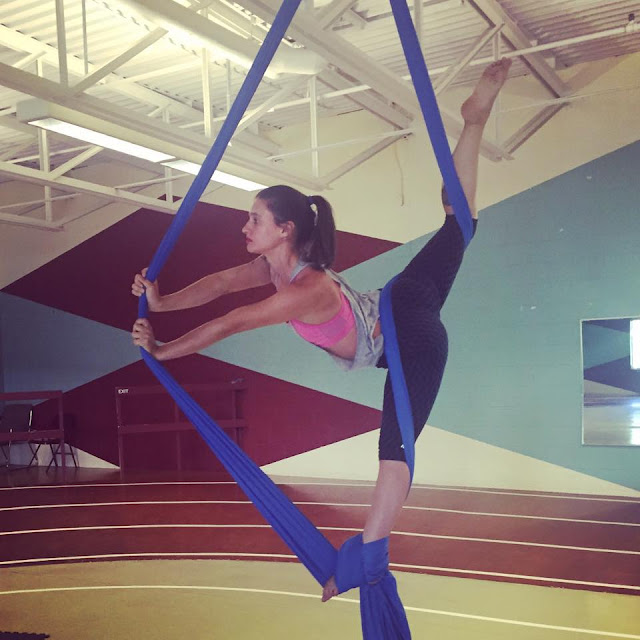9 Tips To Improve Your Aerial Performance
HEY! I've MOVED! Check out this post and more at my new website, AerFit.ca !!!
I have not done a ton of performance yet. I would love to do more but I have a hard time feeling "ready". I know the only way to get better at performing is to take every opportunity to do so! With that in mind I wanted to look into what exactly I could do to improve my performances. After some research and talking with other aerialists I've come up with 9 elements of performing that I think are great to keep top of mind and that will potentially improve the performance.
1. Engagement of feet (pointed or flexed or combination)
Floppy feet just don't look that great. I prefer a point myself, but have seen the use of flexed feet for aesthetic/choreographic purposes and it worked. A pointed foot lengthens the leg and creates an unbroken line that leads the gaze one way or another and is very pleasing to the eye. Either way, do something with that damn foot!
2. Variation in movement speed (pauses)
An act performed at one speed either feels rushed or boring. Obviously as I said, there are choreographic exceptions, however I have yet to find a good example of one. If you move through your entire routine too fast, the audience never gets a chance to appreciate any one trick or move. Too slow, and you risk losing the interest of the audience. Try varying your speed, moving slow and deliberate when it counts, and employing speed and power to grab the attention of your audience. I personally have a tendency to rush through moves, thinking I am pausing enough but looking at recordings of myself and getting feedback, I am moving too fast. This is something to be aware of!
3. Audience engagement / perceived engagement
This is a big one for me. Depending on the theme of your act, you might be flirting with the audience, or creeping them out.. maybe you are looking someone dead in the eye.. or maybe you are smiling innocently. Either way look towards them, and engage in some way. If you grimace or have a neutral face the whole time the audience will feel disconnected and probably think you aren't enjoying yourself!
4. Demonstration of Flexibility & strength
People love this. Show them how hard you've trained while making it look easy. Throw a splits or deep backbend in there somewhere, hang upside down, do a drop or two, pull yourself up using only your arms. These demonstrations always wow the audience.
5. Music choice/ musicality of performance
Music choice is very important. Sometimes we have a say in the music and sometimes we don't, but whatever the music is it is important to pay attention to the qualities of the song and use them in your performance. When the song slows down, reflect that in your movements. When the song speeds up, you speed up. And when the song builds to a crescendo, that is a perfect place to build a drop sequence.
6. Deliberate movement / transitional awareness
This is one of the number one weaknesses I see in beginner Aerialists, myself included. We go through the motions of each trick and all of the transitions are ugly or rushed. The secret to great performance is making each transition look like a trick in itself. This way the audience never suspects when you are in transition and the whole act becomes smoother and more deliberate. One way of doing this is to practice pausing in each transition and posing as if it is a trick on its own.
7. Variation in acsending/ descending
If you ascend and descend the apparatus several times in the same fashion, your audience may lose interest. Try making each accent and descent different in your act and see how it changes the quality of your performance.
8. Emotional involvement/ passion
This one is kind of similar to audience engagement but it's more internally focused. Don't be a robot up there. If your act has a theme, try to embody that theme in your movements and facial expressions. If it is a sad act, show the audience with your movements that you are sad. You can tell when a performer is passionate about what they are doing or when they are just going through the motions. A good exercise that I learned at a performance workshop is to pick a short sequence; then, write down a happy or sad or scary moment in your life and meditate on that moment/event/emotion. Next, embodying that emotion, perform your sequence. Try it several times with different emotions.
9. Long lines/ unbroken lines
This kind of also goes with the engagement of feet. The main point here is to be aware of your lines. What kind of aesthetic do you want for your act? Watch your bent elbows and wrists, your bent knees etc and keep in mind that those will break up lines. In general it is probably best practice to engage with long lines and pointed toes. straight legs, straight arms etc. There are many exceptions, but it is important to be deliberate in whatever you choose.
What other elements do you think make up a good performance?












0 comments: